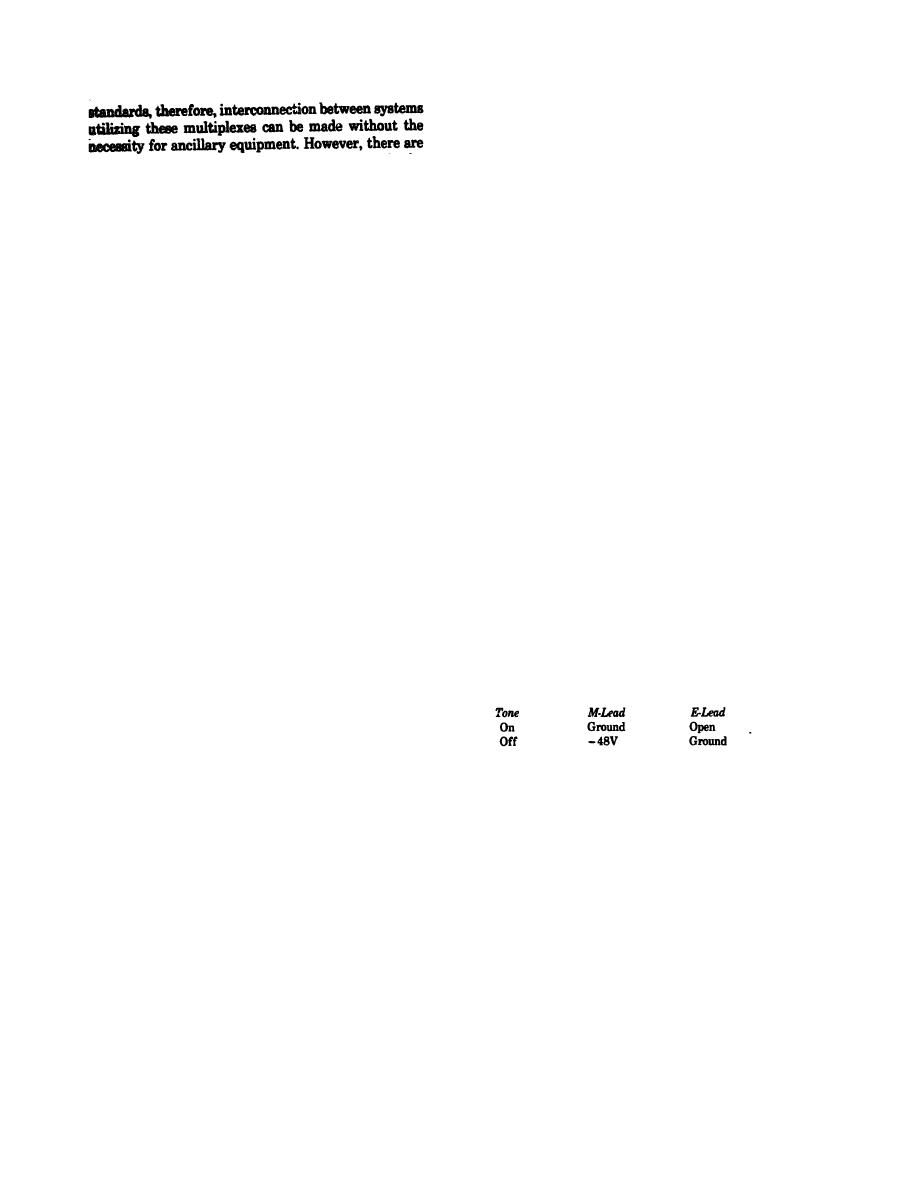 |
|||
|
|
|||
|
|
|||
| ||||||||||
|
|
 TM 11-5895-1012-10
ate such that if any one user transmits a message, it is
received by all others in the group. The network allows
any user to transmit as long as only one station is
transmitting at any particular moment. The hubbing
a considerable number of FDM terminals in use in the
repeater may be used as the interface device between a
DCS which do not utilize the standard parameters.
Send Only device and several receiving terminals.
When interconnection at the group or supergroup level
d. Passive Peak Limiter. This unit is used to auto-
is required between this nonstandard equipment or
mat&By prevent system overload causes by excessive
standard to nonstandard equipment special condition-
transmission levels from the user equipment This
ing equipment is required between the multiplexers
equipment is located on the equipment side of the
for the purpose of level compatibility and impedance
Equal Level Batch Bay within the conditioning string
matching. This conditioning equipment is connected
on audio channels.
in the same manner circuit conditioning equipment
e. 6-Way 4-Wire Bridge. This unit provides a con-
would be connected on the circuit level.
ferencing capability for 6 each 4-wire telephone cir-
c. Nonstandard multiplex equipment in use in the
cuits.
DCS generally does not utilize the same pilot fre-
quency as that used in the standard parameter (104.08
2-34. Signaling Equipment
kHz). When multiplex utilizing different pilot fre-
The signaling equipment in the Technical Control
quencies must be interfaced at group or supergroup
Facility provides the means of interfacing ringing and
levels, pilot conversion is required. This process is re-
dial pulse signaling between two different cross-con-
ferred to as pilot stop and reinjection. Suitable equip
nected channels. The equipment is also used to change
ment must be provided which will stop the unwanted
the signal from out-of-band signaling to in-band sig-
pilot frequency and permit insertion of the required
naling. Various types of signaling equipment is dis-
pilot frequency. Equipment which perform these func-
cussed below.
tions are commonly called pilot stop and reinjection
a. Single Frequency Signaling Units (SFSU). This
filters, and are especially designed for interface at the
equipment is used when it is necessary to convert from
pilot frequencies of the multiplex terminals.
E&M signaling to in-band 2600 Hz or 1600 Hz signal-
ing or in-band to E&M signaling. The SFSU transmit
section converts dc-dialing or supervisory signals pres-
Technical Control Facility personnel will be required
ent on the M-lead into an amplitude-modulated tone
to be familiar with the operational and technical char-
for transmission over voice frequency channels. The
acteristics of other ancillary equipment which may be
SFSU receive section converts received amplitude
required to assure proper operation but which are not
modulated tones into dc-dialing or supervisory signals
usually referred to as conditioning equipment.
on the E-lead. The state of the E&M leads may be
a. Four to Two-Wire Terminating Sets. The four to
grounded, +48 vdc, or open circuited. The normal
two-wire terminating set is used between a two wire
VF channel and a four-wire VF channel. It converts
E&M logic is as follows:
`the two wires used for transmit-receive to two wires
for transmit and two wires for receive. Usually the ter-
ities, enabling 600-ohm 4-wire circuits to be con-
b. E&M/Loop Converter (E&M to Dc). The dial loop
nected to 600- or 900-ohm 2-wire circuits.
to the E&M converter provides complete access be
b. 600-Ohm Terminations. The normal terminated
tween a central office and a dial user instrument over a
impedance of lines used in telephone work is 600
voice frequency carrier channel. There are two ver-
ohms, although some 900 ohm terminations may be
sions of this unit as follows:
used. When the equipment normally used to provide
(1) Central Office Dial Loop to E&M Converter.
proper termination is removed, the Technical Control-
This unit receives 20 Hz from the central office and
ler must have available a rapid method of terminating
converts it to an M-lead seizure for input to an SFSU
lines so that any test measurement made on the line
in the outgoing direction, and presents a closed loop to
will be accurate. A device in common use in Technical
the central office when the E-lead from the SFSU in-
Control Facilities is a terminating resistor which is
dicates an incoming call.
usually a noninductive resistor of the proper value
(2) User Dial Loop to E&M Converter. This unit
wired across plugs of the same type as those used at
recognizes a closed loop when the user goes off-hook
the patch panels.
and indicates seizure to the M-lead and converts dial
c. Data Conferencing Network. This device (also
pulses to M-lead pulsing of the SFSU. When a call is
known as a Technical Control Facility Hubbing Re-
incoming to the user the E-lead causes a 20 Hz ringing
pester) enables a predetermined group of users to oper-
signal to be sent to the end instrument.
|
|
Privacy Statement - Press Release - Copyright Information. - Contact Us |